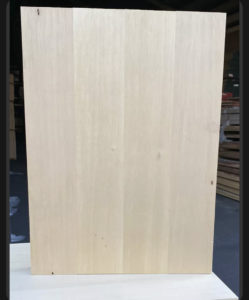Jelutong: Fine Uniform Grain & Soft Density
Jelutong lumber is named after a constituency in Penangm, Malaysia where is grows. The Asian hardwood carves & machines silky smooth.
While perhaps best known as a source for latex, jelutong trees also produce low density wood that carves and finishes with ease. The sapwood is tapped to produce latex similarly to how North American Maple trees are tapped for syrup.
Additionally, if you’re looking Jelutong wood for sale, it’s sold right here at Commercial Forest Products in Fontana, California.
In fact, Jelutong lumber is a favorite hardwood among experienced wood carvers, pattern makers, wood turners & sign makers for 3 reasons.
- Fine Grain
- Straight Grain
- Low Density
These characteristics make it ideal for carving & turning applications. Its tight closed pores and uniform grain allow woodworkers to cut intricate details without grain tear-out. Model makers love Jelutong wood for the same reason.
Additionally, the consistent light pale color of jelutong timber stains easily and consistently.
The machinability of jelutong hardwood is special, in my experience. There are only few hardwood species with similar low density. Earlier this week, while grading some 8/4 Jelutong lumber in our yard, I created an indentation using only the light pressure of my thumbnail. It’s really that soft!
Jelutong Lumber: What To Know
Where Is Jelutong Grown?
This fast-growing Asian hardwood grows primarily in Indonesia, Borneo, Singapore, Thailand, Malaysia and Sumatra. The trees have a plain appearance after harvesting. Accordingly, they have many commercial applications.
Jelutong Wood Suppliers Nearby
Woodworkers in the United States looking for Jelutong wood have few choices. Often, nearby lumber stores sell only popular exotic species like mahogany, sapele, and Spanish Cedar.
Why Is It a Great Carving Wood?
Since I am a hardwood lumber distributor and only an amateur woodturner, I defer to renown woodcarver Chris Pye. In additional to its soft easy machining, jelutong provides a pale canvas. This highlights intricate carving details that are lost in a darker, more defined wood specie. This is especially relevant in smaller scale carvings.
How to Recognize Dyera costulata
Other than relatively light weight, jelutong has pale yellow to cream coloration that finishes to a bright luster. Its grain lines are fine and indistinct – less so than maple or poplar. Additionally, it’s difficult to even see the growth rings when looking at an end-cut.
In fact, the light uniform grain lines makes it a reasonable substitute for ultra expensive holly. The one major difference between holly and jelutong wood is the color. Well dried holly is bright white while jelutong is more of a pale off-white color.
One thing to note is that jelutong’s color changes over time. Similar to Cherry and Padauk, this is a result of oxidization.
Fresh cuts of well-dried jelutong timber are bright white. Over time, it oxidizes to more of an off-white / pale yellow color.
Is Jelutong a Softwood or Hardwood?
It is a dicot tree. Thus, Jelutong is a hardwood.. However, it is a soft, lightweight hardwood. It shares many characteristics with other soft hardwoods such as basswood, balsa, paulownia, primavera, aspen and poplar.
What is Jelutong’s Biggest Advantage?
Woodworkers who prefer jelutong normally do so for it’s machineability. Its low density allow for easy cutting and milling. It doesn’t matter whether you use hand tools or power tools, the cuts are clean and crisp.
Additionally, Jelutong trees are used in the production of latex paint. Historically, its latex was used as the base for chewing gum and used as a rubber substitute.


Pingback: Paulownia - Lumber - Wood - 8/4-2021